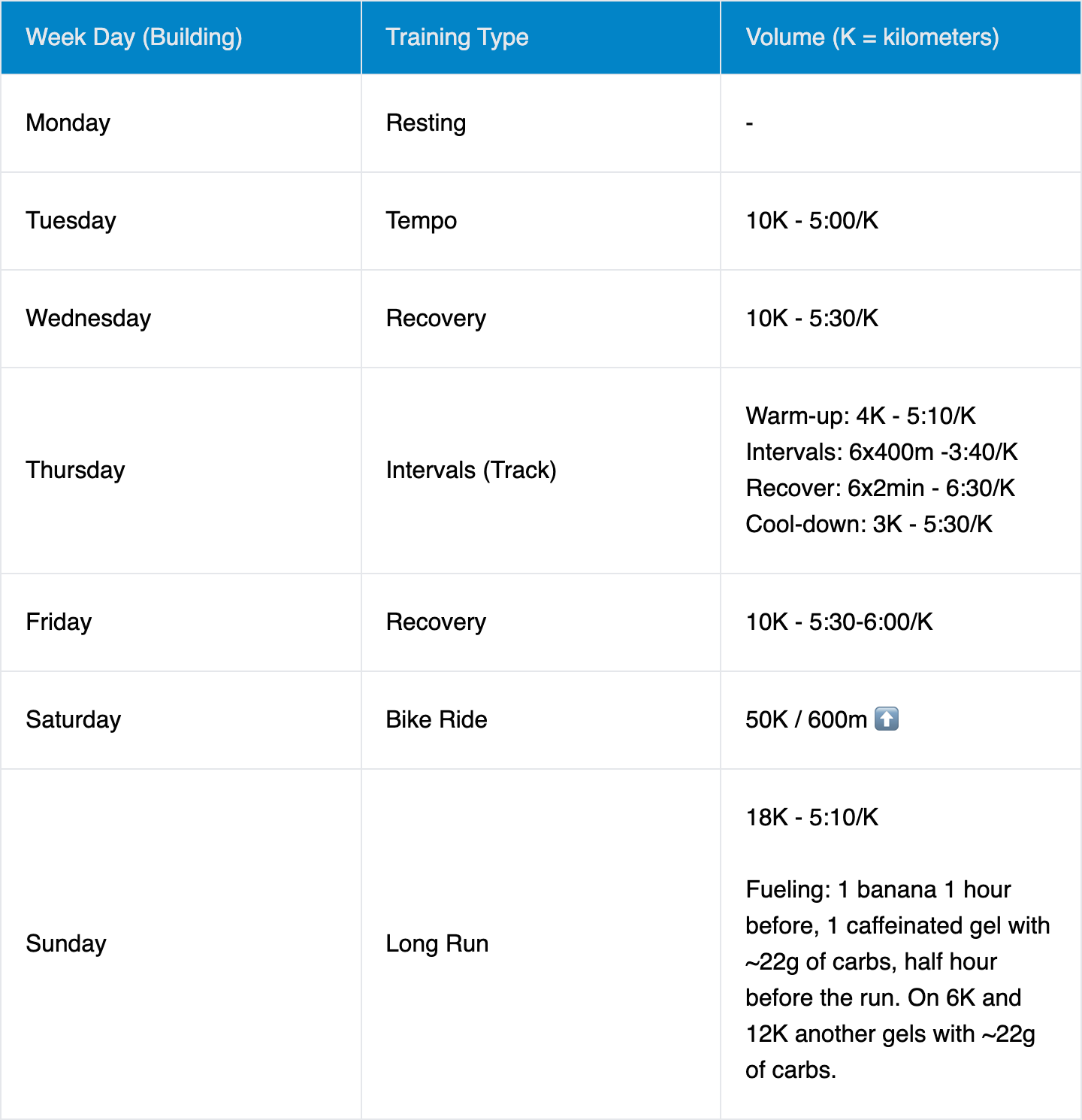I was almost sure that I will fail here. Starting three-months plan I thought I will have enough ability to follow the schedule and not postpone any of my trainings. I was wrong. Why? It might be stupid and prosaic reason but, my had-to-deliver business trips destroyed it. But from the beginning.
Week #3
You can read more about the structure of Week 2 of my building phase here. Week 3 followed a similar pattern, with consistent effort across all my planned runs, but I made a few tweaks to push myself further. I increased the intensity slightly, especially during my tempo runs, and added an extra fast-paced interval to my track session. It felt great - I could sense real progress and forward momentum. Below, you’ll find a detailed table with all the sessions I completed during the week.
The failure of weeks #4 and #5
Let’s get straight to the point. When I started planning for this challenge, I knew the first month of my 3-month preparation period would be tough. Quick reminder: my first race is in Seville at the end of January. From everything I’ve read and researched, it’s clear that aiming for any ambitious goal - like finishing my first half marathon of the year in under 1:45 - requires a solid 3-month training block (If you’re new here, you can read more about my project here). And that’s applicable for any shape, of course you’ll be not able to jump from nothing to 1:15 on your first race, but on 3rd, 5th, who knows. It all depends from your determination and the general process of building it - your shape and fitness.
It’s worth noting that I wasn’t starting from scratch. I’ve been a hobby runner for a while now, covering decent distances weekly and gradually improving my pace, but without much structure. This challenge gave me the perfect reason to take my training seriously, build a solid foundation, and track progress consistently. For me, having a clear plan on paper makes it all feel more purposeful than just running for the sake of running. Sure, you can do it for health - and that’s great - but there’s something extra motivating about pushing yourself to compete, to see what you’re truly capable of.
This first month didn’t go exactly as planned. I had two back-to-back trips - one for business and one for family - which turned my schedule upside down. I naively thought I could stick to my training plan and maybe skip just one session, but I was so wrong. First, packing was a challenge. Traveling with only a backpack meant I couldn’t bring all my gear, especially given Poland’s colder temperatures compared to warm Portugal. I struggled to pack proper clothing, and bringing two pairs of running shoes was out of the question. Instead, I resorted to walks and some light hiking to stay somewhat active.
When I got back home, I made the classic rookie mistake: trying to make up for lost time. I pushed too hard, cramming in missed kilometers, and overdid it completely. By the third day of my fifth week, I was utterly exhausted. Fatigue hit hard, and one of my runs a day after left me dealing with severe cramping and breathing issues. Recovery took about 3-4 full days of doing almost nothing but easy walks. Today, I finally managed my first 10K again, and thankfully, I felt great.
But this experience taught me an important lesson: being reckless and overambitious doesn’t work. Consistency and smart planning are what really matter. Now, I have a full two-month training block ahead to prepare for the Seville half marathon in January. I’m committed to a structured, disciplined approach—and most importantly, to listening to my body. Let’s consider this first month a valuable “prep phase,” especially for anyone just starting out without much running history. Time to reset and do this right.
The Plan
I’m not planning to downgrade my goals - my time and distance targets remain unchanged. I’ll stick with the original plan and share a detailed summary of the process once this preparation phase is complete. Honestly, I’m feeling good about this setback because the lessons I’ve learned will be invaluable for future planning and building, especially with my unconventional AI-driven approach.
One more thing: I’ll be adding an additional metric to my tracking - my weight. Shedding a few kilos is essential to hitting better times in upcoming races. While my current weight isn’t “extreme”, it’s still holding me back from achieving my full potential. So, it’s time to tackle this head-on. Let’s do this!


